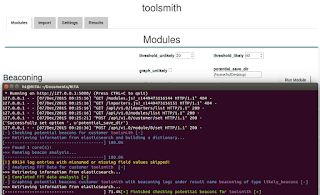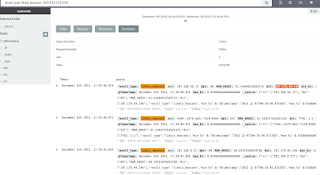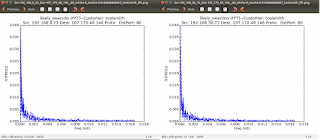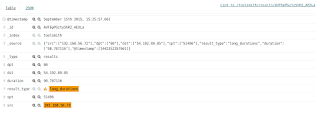We benefit this month from another offering first spotted via my fellow tool aficionados over at Toolswatch. And just like that, bam! A Beatles song…stuck in my head…all day.The crazy crew at Blackhills Security have embarked on another cool project: Real Intelligence Threat Analysis, or RITA, thus named because “Johns’ mom” was already taken.
 |
Yep, that kind of crazy  |
This is the team who’s brought us ADHD (Active Defense Harbinger Distribution and Recon-ng, both prior toolsmith topics. As such, I stalk their site, blog, and Twitter accounts like a tool nerd possessed, waiting for the next set of interesting bits to drop. RITA is very young in its development life cycle, not yet even two months from its initial release as this is written. That does not mean it should not be brought to your immediate attention. On 4 DEC the Black Hills Info Sec team updated RITA’s Bro logs import capabilities, her moment had arrived.
From RITA’s readme.md: “RITA is a toolkit which is intended to help approach the often overwhelming task of combing through piles of log data looking for suspect behavior.
RITA is intended to help in the search for indicators of compromise in enterprise networks of varying size. The framework was instructed by it’s engineers experience in penetration testing with the question of how they’d catch themselves, thus the analysis tends to looks specifically at the indicators their tools tend to leave behind.” This is the basis of a contemporary hunting practice, the definition of proper red team / blue team give and take. Emulate your adversary with the same tools they’d use (red), then write and implement detection and alerting logic to identify that same activity. You’ll force your red teams to become stealthier while improving your blue team tactics, all the while improving your likelihood of catching average and less sophisticated adversaries.
John and team have endeavored to document RITA, and while the docs are raw, they’ll definitely get you under way. Here’s a bit of a manifest to help bring you up to speed:
1) Initial video
2) Initial blog post
3) Release notes
4) Initial overview
5) Bro logs import overview
6) OVA for your preferred virtualization platform (works like a charm on VMWare)
Read all the docs, that’s an order, but I’ll give you my exact setup steps, which borrow liberally from the docs above…that you’re supposed to read.
1) Download and import the RITA OVA. Username: ht, password: !templinpw! (change it).
2) Crack open a terminal and run sudo apt-get update && sudo apt-get upgrade. Good time to take a VM snapshot.
3) Download bro_logs.tar.gz and logstash_script.tar.gz.
4) Create a logs directory, I used mkdir /home/ht/Documents/toolsmith.
5) Unpack bro_logs.tar.gz in your new directory, it created /home/ht/Documents/toolsmith/logs for me.
6) Unpack logstash_script.tar.gz in the new logs directory.
7) cd logstash_script.
8) chmod +x run.sh.
9) Edit bro.conf (line 128) such that imported Bro logs write to an index of your choosing. You’ll be shocked to learn that I chose toolsmith.
10) ./run.sh ../bro_meterpreter/2015-* ../dns_bro/2015-* ../powershell/2015-*
 |
| Figure 1: Import in progress |
11) Browse to http://localhost:5601 to access Kibana. RITA runs on an ELK stack if you haven’t figured that out yet. 
12) Go to Settings tab, change the index name to that which you selected above and add @timestamp under Time-field name resulting in something like Figure 2.
 |
| Figure 2: Kibana Settings |
13) Go to Discover, and change time range from Last 15 Minutes to Last 5 Years. If all’s gone to plan you’ll see 572,687 entries.
14) Back at your terminal, cd Documents/RITA.
15) python run.py
16) Browse to http://localhost:5000 for the RITA UI
17) Enter the name of the index you created, should appear as in Figure 3
 |
| Figure 3: RITA UI |
RITA gives you these capabilities in her current release:
Beaconing
Connections that happen frequently and on similar intervals could be an indicator of malware calling home
Blacklisted IPs
Blacklisted IPs are addresses reported as being involved with malware, spamming, and other dangerous activities
Scanning
These events occur when a computer attempts to connect to a large number of ports on a system, searching for vulnerabilities
Long Durations
Connections that are beyond the length of average on a network could indicate a compromised system
Long URLs
Longer than normal URLs could potentially be used to transfer malicious data into the system
Concurrent Logins
A user being logged into a high number of systems could indicate that this user’s account or original system has been compromised
Under Beaconing, change potential_save_dir to /home/ht/Desktop/ then click Run Module.
While you wait, you can watch progress in you terminal window.
 |
| Figure 4: Beacon analysis progress |
Again, browse to http://localhost:5601, go to Discover, and change time range from Last 15 Minutes to Last 5 Years. You’ll see a slew of results for “unlikely beacons”; this will not do. We need likely beacons, or what’s the point? Search result_type:likely_beacons, and dig deeper. A number of the results seek destinations that are multicast addresses, let’s filter those out. I tried result_type:likely_beacons -239.255.255.250 and shrunk to load to three hits, two of which shared a destination IP of 107.170.48.146 as seen in Figure 5.
 |
| Figure 5: Filtered beacons |
You should also see a number of PNG result files in /home/ht/Desktop by the way, which will visually help you confirm, Figure 5 does exactly that. Source IPs 192.168.56.72 and 192.168.0.23 are both communicating with 107.170.48.146 over HTTP.
 |
| Figure 6: Beacons |
The beaconing is identified via a Fast Fourier Transform algorithm (FFT) generating graph that represents the results based on the time stamps for a given source/destination connection.
For continued pursuit of a culprit I then filtered with src:192.168.56.72 AND dst:107.170.48.146 -unlikely_beacons, which resulted in 49,611 hits.
Maybe an additional focus area from RITA’s list such as Long Durations? Yep, that worked. result_type=long_durations AND src=192.168.56.72 returned 60 hits including 54.192.89.85. That IP belongs to Amazon Web Services, nobody ever uses a cloud node for exfil or C2 during hacks or pentest work, right?  A long connection at odd hours bound from one of your source IPs to an AWS node could be quite interesting and worth a closer look.
A long connection at odd hours bound from one of your source IPs to an AWS node could be quite interesting and worth a closer look.
 |
| Figure 7: Why is my IP having a long chat with an AWS node? |
Another interesting pivot may be to see what else your source IP has been up to at this point. I tried result_type=scanning AND src=192.168.56.72 and…what!…a scanning hit?
 |
| Figure 8: Scanning |
You may notice that the dates are wonky, they represent when I ran the query rather that the date of the actual scanning activity. I re-queried just the destination IP, 67.215.250.139 in this case, and returned correct time stamps: September 16, 2015.
Sure, these are sample logs, but as an exercise opportunity, the work beautifully conveying how important it is to analyze from multiple perspectives.
Wrap Up
Yes, RITA is work in progress, but if you use it only as an excuse to improve you ELK stack fu, you’re already winning. Yes, we all love Splunk, but no we cannot all afford it. RITA and ELK go a long way down the path to free and open source alternatives, particularly for Bro users, which you should all be.
Keep an eye on this project, I love where it’s going, I’m betting the futures for this one.
Ping me via email or Twitter if you have questions: russ at holisticinfosec dot org or @holisticinfosec.
Cheers…until next month. Continue reading toolsmith #111: Lovely RITA, may I inquire?→






